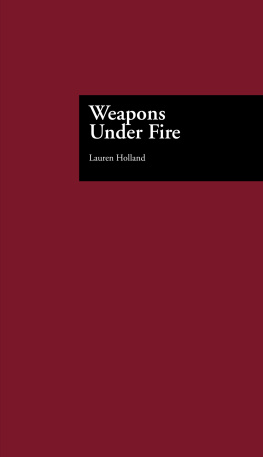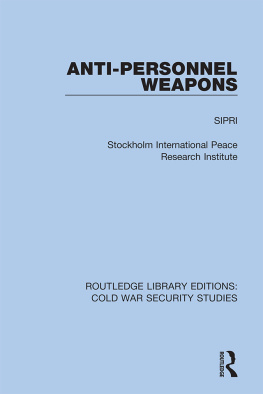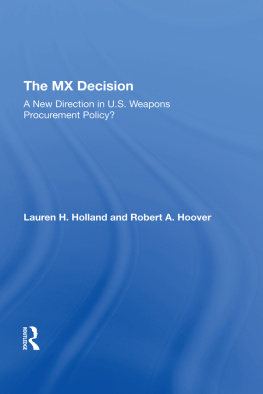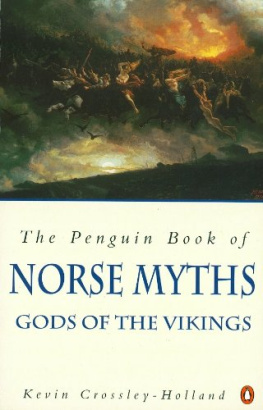Weapons Under Fire
Lauren Holland
First published 1997
by Garland Publishing, Inc.
Published 2013 by Routledge
2 Park Square, Milton Park, Abingdon, Oxon OX14 4RN
711 Third Avenue, New York, NY, 10017, USA
Routledge is an imprint of the Taylor & Francis Group, an informa business
Copyright 1997 by Lauren Holland
All rights reserved
Library of Congress Cataloging-in-Publication Data
Holland, Lauren H.
Weapons under fire / Lauren Holland.
p. cm. (Garland reference library of social science ; v. 1047)
Includes bibliographical references and index.
1. United StatesArmed ForcesWeapons systems. I. Title.
II. Series.
UF503.H65 1997
355.8'0973dc21
97-21805
CIP
ISBN 13: 978-0-815-32067-8 (hbk)
ISBN 13: 978-0-815-32068-5 (pbk)
For the figure on page 69, from Alexander Kossiakoff, in Franklin A. Long and Judith Reppy, The Genesis of New Weapons: Decision Making for Military R&D, every effort was made to contact the copyright holder of this source. We were unable to do so and would welcome any further information.
Figure on page 72 from The Politics of United States Foreign Policy by Jerel A. Rosati, copyright 1993 by Holt, Rinehart and Winston, Inc., reproduced by permission of the publisher.
For Nick
CONTENTS
Tables
Weapons Systems by Representative Criteria
Weapons Systems by Performance Criteria
Structure of the Pentagon: Who Rules?
Does Military Need or Organizational Position Prevail?
Compromise (Concessions) by Performance Problems
Impetus for Weapons Systems
Weapons Systems by Scope of Participation
Scope of Participation by Performance
Technological Sophistication by Performance Problems
Congressional-Executive Relations on Major Weapons Systems
Nature and Scope of Public Involvement/Influence
Public Involvement by Performance Problems
Public Involvement by Cost Overruns
Public Involvement by Schedule Delays
Figures
How Nuclear Weapons Decisions Are Made
The Cycle for Major Weapons Acquisition
Department of Defense Policy Processes
PREFACE
For forty-five years, in the aftermath of World War II and Americas inauguration of the nuclear age, fear of Soviet aggression and Communist expansionism provided the primary impetus for the shape of Americas force structure and posture. During this time, every rifle, missile, tank, submarine, and plane that was built was justified as promoting Americas national security in light of the Communist threat.
There is no longer a Soviet Union. The threat of Communism has evaporated. Regional conflicts prevail among the diverse ethnic groups that once composed the nations of the Warsaw Pact. Yet America continues to build the same weapons conceived for use against the Soviet Union and its allies during the period of the Cold War. In part, the securityweapons mismatch is understandable given the life cycle of most major weapons systems (five to fifteen years) and the capacity for redesigning weapons for new applications. The stellar performance of the M-1A1 tank in the Persian Gulf during Desert Storm is one example of the second phenomenon.
Another part of the explanation can be found in Congress and the Pentagon. In Congress, the Cold War mentality prevails. During the fall of 1995, the U.S. Congress approved funding for a new fleet of B-2 (Stealth) bombers that even the Pentagon disclaimed because the planes mission, to penetrate Soviet air defense and attack hardened targets, is no longer relevant. For its part, the Pentagon, guided by a two- (regional or one-half) war strategy, (Quadrennial Defense Review, May 1997), is seeking billions for a third Seawolf attack submarine (originally conceived to track and destroy Soviet ships) and a new RAH-66 Comanche helicopter (originally conceived to defeat the Soviets Hokum helicopter). Congress already has approved $1.5 billion for the submarine and $300 million for development of the helicopter. During the spring of 1996, congressional Republicans sought (unsuccessfully) to revive a scaled-down version of the Star Wars missile defense system.
As the media clamor to portray current legislative politics as wasteful and parochial and Pentagon activities as business as usual, students of defense policy run to defend their more scientific explanations of why and how America comes to the decisions that it does to build the weapons. It is becoming increasingly difficult for the scholarly community to defend against the claims that the Pentagon Gets a Free Ride and Military Pork Continues. This defense, however, is the task that I have set out for myself in this now timely book.
In my search for a reconciliation of the divergent views from the academic and media communities, I have found that there is a middle ground. There is a lot of pork in legislative politics, malfeasance in the Pentagon, and negligence in the defense industry. But there are also good intentions, a great deal of competence, and serious efforts to match Americas military capabilities to credible future threats. Validating the middle ground requires looking further than the House Committee on National Securitys actions on the B-2 bomber, President Clintons campaign promise to support the Seawolf submarine, and the Pentagons use of a concurrent and risky management strategy for the $71.6 billion F-22 fighter aircraft program. It necessitates a dissection of the decision-making process for a representative sample of major weapons systems to invalidate the claims that pork and malfeasance are both pervasive and determinate. This book attempts just such a comprehensive analysis.
ACKNOWLEDGMENTS
A number of people assisted in writing this book. Those with whom I held confidential interviewsthirty people serving in the Pentagon, Congress, and academiacontributed enormously to the information in it. Most of the formal, personal interviews were conducted in the fall of 1988 and again during the summer of 1991. Of the several graduate and undergraduate students assigned to me as research assistants, one deserves particular mention. Crae Franklin collected voluminous numbers of government publications and secured additional information while on a research trip to Washington, D.C., during the summer of 1991. The National Science Foundation provided me with the time, resources, and confidence to make researching this book possible; my gratitude to them is indescribable. The suggestions offered by the five anonymous reviewers commissioned by Garland Publishing were insightful and kind. My colleagues Susan Olson and Dan McCool offered timely encouragement. Senior Editor David Estrin was nothing less than exuberantly persistent. Finally, I wish to thank my son Nick who (despite his youth) has been a constant source of love, joy, and humor and a persistent reminder that there are more rewarding, fulfilling, and challenging things to do than write a book.
INTRODUCTION
Weapons in the United States are under fire. The evil empire has collapsed and the Berlin Wall has come down. Few firearms are currently being discharged against Americas enemies. But weapons are under fire. They are under fire from the media, which is concerned with the amount of money overspent on military spare parts, and with the persistent crashes of prototype aircraft. They are attacked by some members of Congress, who speak out against the enormous amounts of funds being committed to major weapons systems for which there are no longer military rationales and that fail to perform credible missions. They are assaulted by an American public that no longer finds a defense buildup credible in the current international environment nor cost-effective in the current economic environment.











